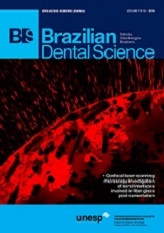Techniques for preparing of guide planes: in vitro comparative study
DOI:
https://doi.org/10.14295/bds.2014.v17i2.936Abstract
The correct parallelism of guiding planes when constructing a Removable Partial Denture not only defines the axis of insertion and removal of the prosthesis, but also limits the possible axes of movement during functioning. Therefore, the purpose of the study was to compare some techniques and the use of an intra-oral device for those preparations. Dummies were performed in a direct manner, simulating the absence of teeth 15, 45, 12 and 42. The four preparation techniques chosen were: Group 1 – freehand preparation; group 2 - guide pins; Group 3 - crown guides and Group 4 - parallel intraoral device – ParalAB. No statistical difference was shown between the mean values of angles found for the freehand (82.85°) and guide pin (83.60°) groups. Also, no statistical significant difference was observed between the mean values of angles found for the resin cap (of 88.83) and intraoral device (88.58 º) groups; however they were superior to the findings for the freehand and guide pin groups. The studied methods are effective for what they were proposed; however, one should select the method according to the experience and skills, to promote the best results.
Downloads
Downloads
Published
How to Cite
Issue
Section
License
Brazilian Dental Science uses the Creative Commons (CC-BY 4.0) license, thus preserving the integrity of articles in an open access environment. The journal allows the author to retain publishing rights without restrictions.
=================




























